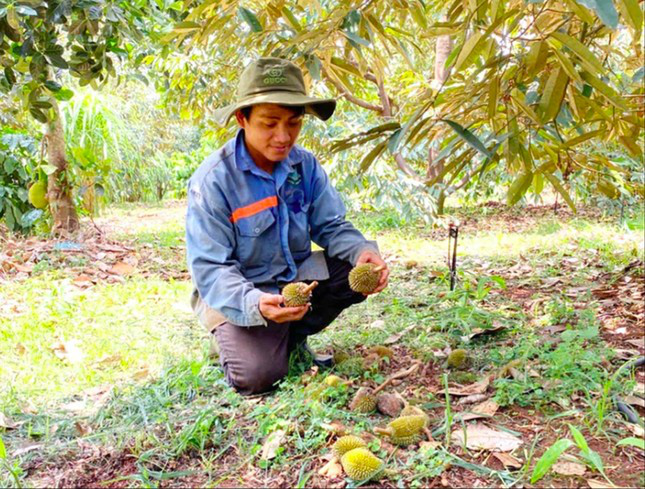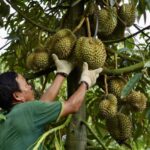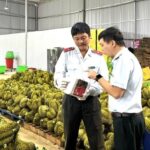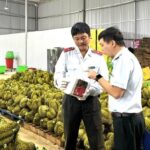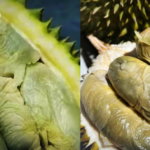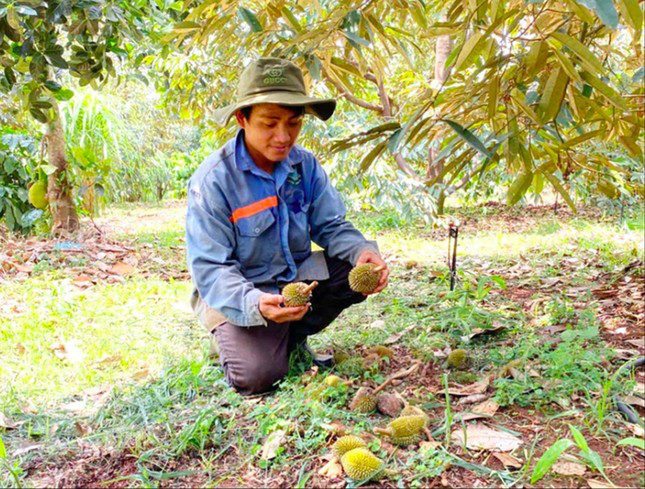
Mr. Luong’s durian garden was full of fruits, but unfortunately, most of them dropped overnight due to extreme weather conditions.
Mr. Vo Van Luong, a 50-year-old durian farmer from Hung Binh Tan Hop village in Ia Yok commune, Ia Grai district, had high hopes for a bountiful harvest this year. However, his dreams were shattered as approximately 85% of the unripe durians on his 80 trees suddenly dropped overnight due to extreme weather conditions.
“I’ve put in so much effort, and now the fruits, which would have sold for no less than VND 150,000 each, have fallen. Each tree now has only a few fruits left, which is disappointing,” shared a dejected Mr. Luong.
In Chư Pưh district, where there are approximately 772 hectares of durian trees, with about 370 hectares being productive, the story is similar. Despite not being affected by frost, Mr. Nguyen Thien Nhat, a 35-year-old durian farmer from Hoa Loc village in Ia Phang commune, has also suffered significant fruit drop due to prolonged heatwaves.
According to Mr. Nhat, the temperature during the day soared to 37-39 degrees Celsius, then dropped sharply at night, causing a “heat shock” to the durian trees, resulting in massive fruit drop.
With 6,387 hectares of durian plantations, Gia Lai province is a significant producer of this popular fruit, especially in districts like Chư Păh, Ia Grai, Chư Pưh, Chư Prông, and Đức Cơ. Mr. Hoang Thi Tho, Deputy Chief of the Planting and Plant Protection Division (Department of Agriculture and Environment), attributed the fruit drop to extreme weather events induced by climate change, including prolonged heatwaves, strong winds, and localized whirlwinds, which affected many localities in the province.
To mitigate fruit drop in durian trees during the fruit-setting stage, Mr. Tho recommended that farmers increase the application of phosphorus, potassium, and silicon-enriched fertilizers, along with magnesium, sodium, and other micro and macronutrients. Additionally, maintaining moisture in the durian garden and adopting drip irrigation technology, with a focus on early morning watering to prevent heat shock in the trees, are crucial measures.
The Department of Agriculture and Environment of Gia Lai has issued documents urging localities to guide farmers in developing durian cultivation sustainably. This includes advising against expanding durian cultivation in areas with unsuitable land and climate conditions, as well as discouraging the clearing of existing crops to plant durian monocultures or converting productive coffee and pepper gardens to durian plantations.
“Unveiling the Truth: Independent Testing of Chemicals in Lam Dong’s Durian”
On May 24, the Department of Agriculture and Environment of Lam Dong province announced that no traces of yellow dye, a chemical previously warned against for illegal usage to artificially color fruits, were found in hundreds of tested durian samples across the region.
“The Banking Sector’s Early Embrace of Green Credit: Scaling Up and Accelerating Sustainable Lending”
On May 21, 2025, the State Bank of Vietnam (SBV) hosted a seminar to promote the implementation of the banking sector’s Action Plan for the National Green Growth Strategy for the period of 2021-2030. The event also witnessed the launch of the “Handbook of Environmental and Social Risk Management System in Credit Activities”. Mr. Dao Minh Tu, SBV’s Permanent Vice Governor, attended and chaired the seminar.
The Exotic Durian Look-alike Taking Asia by Storm: Rare Green-hued Pulp, Priced at Over 700,000 VND per kg, Hitting Shelves in June.
Introducing the latest craze sweeping across Asia – the coveted durian fruit from [Country]. With its unique flavor and texture, this durian variety is taking the continent by storm, commanding a premium price and leaving enthusiasts in a frenzy. Unveiling the secrets behind its allure, this exotic delicacy promises an unparalleled sensory experience, captivating even the most discerning palates.


























